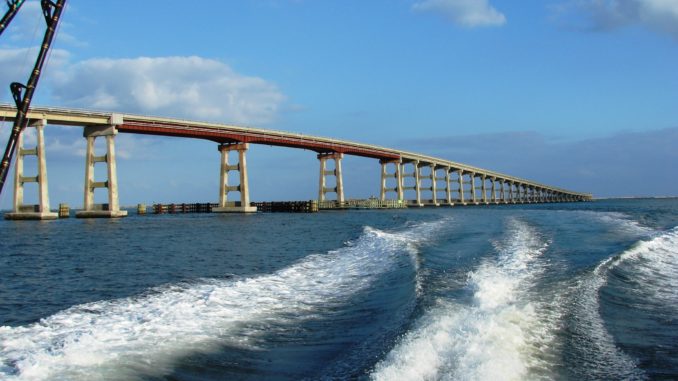
Five months after extensive dredging, inlet is down to two to four feet of depth
It took $7.8 million in dredging to get Oregon Inlet passable last fall. It took about five months for Mother Nature to take it back.
The inlet, the northernmost along North Carolina’s coast, has filled in to the point that boats found only two feet of water for passage a couple of weeks ago, and only four feet earlier this week after a side-cast dredge was able to move sand from the bottom. Boats from commercial and charter fleets, along with recreational anglers, regularly use the inlet to access the Atlantic Ocean from nearby ports, including Wanchese and Manteo, and from inland areas on the western side of Pamlico and Albemarle and Currituck sounds.
The main problem is that the section of the channel that runs under the Herbert C. Bonner Bridge; it is the shallowest spot and the spot that refuses to stay dredged. Many boats that are using the inlet are not crossing under the bridge at the center span but are using a deeper but narrower span nearby. The center span is the only spot in the bridge designed for boat traffic and is wider, with bulkheads around the pilings. A private boat attempted to go through one of the narrower spans last fall and misjudged the current badly enough it crashed into the bridge and sank.
“You have no room for error doing that,” said Jamie Reibel, a charterboat fisherman on the board of the Commission for Working Watermen. “Everybody’s scared to death of the place.”
Late last fall, Oregon Inlet was dredged to a width of 400 to 600 feet and a depth of 14 to 15 feet. That extensive dredging was funded by $7.8 million in disaster-relief funds from Hurricane Sandy, and it was the best shape the troublesome inlet has seen in several decades.
The dredges Merritt and Currituck worked through the winter and spring to keep the inlet passable after it began filling in.
The Army Corps of Engineers has the unending job of keeping Oregon Inlet open. Oregon Inlet was created by a storm in the 1840s, and keeping it open requires attention every day. Funding for the daunting task has been cut drastically, with more declines in the works.
Roger Bullock, chief of navigation for the Corps’ Wilmington District, said, “The Oregon Inlet to Manteo area used to receive nearly $8 million in annual funding a decade ago, but that has dropped to $1 million annually in 2009 and dropped again to $800,000 in the current federal budget. The problem is, there is only so much money to go around, and it costs an estimated $4 to $5 million a year to keep the Oregon Inlet’s channel open.”
Oregon Inlet was not included in the legislation that raised boat-registration fees to help fund dredging for North Carolina’s shallow-draft inlets. Funds have always been provided by the federal government to assist fishing operations on the Outer Banks and as a deep-water entry to safe harbor between MoreheadCity and Norfolk, Va.
Elected officials and the local fishing industry frequently lobby for more federal and state funding. Charter and commercial fishing, boat-building and seafood-processing industries that depend on Oregon Inlet generated a $682.7 million annual benefit to Dare County, according to a 2006 study. The state has stepped in before, most recently under former Gov. Beverly Perdue, and is willing to again. The state has agreed to match county money up to $2 million for Oregon Inlet maintenance dredging.
Warren Judge, chairman of the Dare County Board of Commissioners has a plan to submit to the state legislature when it convenes next month. His plan includes options for maintaining the inlet, one of which is transferring ownership of both shorelines from the U.S. Interior Department to the state. That would speed the ability to react and make some options easier to follow, but the transfer and permitting process could take years.




Be the first to comment